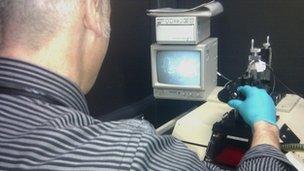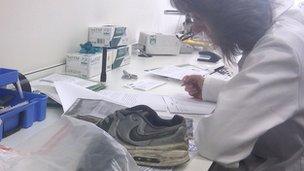CSI-style lab 'vital' in Yorkshire and Humber crime fight
- Published

Forensic scientists at the forensic labs in Wakefield have access to the latest technology
From the outside, it looks more like a swanky corporate headquarters than a 21st Century scientific laboratory, but once inside this building just off the M1 in Wakefield its role becomes much clearer.
Some describe it as "CSI Wakefield" but, unlike its fictional television counterpart, the white coats and impressive array of scientific equipment found around every corner at the Regional Police Forensic and Scientific Support Building are very real - and so are the criminals they are hoping to catch.
Opening last month at a cost of £21m, it has been described by West Yorkshire Police's Assistant Chief Constable Mark Milsom as playing a "vital role" in the battle against crime and anti-social behaviour, not just in Yorkshire and the Humber but across the country.
However, that battle often comes down to some very mundane details.
Identification expert Ryan Harris, for instance, spends much of his working life at the newly-opened laboratory in other people's shoes - literally.
"I'm currently working on a footwear case involving three pairs of training shoes," he explained.
"What I'll do with these shoes is that I'll actually wear them - with bags on my feet, obviously - and make some control test impressions from them.
"This particular case is a burglary so I'll carry out a comparison with the shoes and the marks at the crime scene."
'Fantastic opportunity'
Mr Harris said footwear evidence was used on a regular basis by West Yorkshire Police in an effort to catch criminals.
He and his colleagues had even compiled a list of the top 50 training shoe sole patterns which had been found at crime scenes in the region.
Mr Harris welcomed the opening of the new facility, having spent years working in cramped conditions in West Yorkshire Police's headquarters in Wakefield city centre.
"They were quite dated and not really for the 21st Century," he said.
"What we have here is a fantastic opportunity to build on forensic science in the region."
Named after Sir Alec Jeffreys, known as the father of DNA fingerprinting, the new facility in Wakefield is home to West Yorkshire Police's Scientific Support Department, the force's imaging and scenes of crime units and its DNA Bureau.
It is also home to about a million fingerprint files, including those of the infamous Yorkshire Ripper.
The centre's opening comes less than two months after the closure of the forensic science laboratory in Wetherby as part of the winding down of the Forensic Science Service (FSS), with the loss of 150 jobs.
West Yorkshire's Assistant Chief Constable Mark Milsom said the opening of the Regional Police Forensic Building had proved to be a case of good timing.

Examining footwear is one of the ways the new lab can help in the fight against crime
"Had we not built this building, all the jobs would have been lost to the region from the Forensic Science Service," he said.
"We've actually now got a private provider working on site in the building with us who has taken over from the FSS, and 80 members of staff are from the FSS at Wetherby.
"It is the best police forensic science laboratory in the country."
Neil Denison, head of scientific support at the facility, said the fact that members of the West Yorkshire force were working under the same roof as forensic experts could only improve the chances of crimes being successfully solved.
Now, said Mr Denison, it was time to take on an even bigger role.
"It's intended that this facility is going to become the regional centre for forensic science and we do already share our equipment elsewhere in the country as it's very expensive."
Continuing his examination of the training shoes which could prove key to convicting a burglar, Mr Harris said the move to the new Regional Police Forensic and Scientific Support Building would be a great boost to the crime-fighting effort in the region.
"By having the forensic service provider alongside us, we've got the full crime scene-to-court process - right on our doorstep, right here in Wakefield."
- Published30 March 2012
- Published27 March 2012